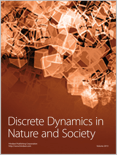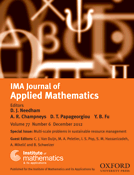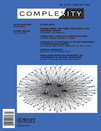
DISCRETE DYNAMICS IN NATURE AND SOCIETY
Scope & Guideline
Unraveling Complexities in Nature and Society through Discrete Dynamics
Introduction
Aims and Scopes
- Mathematical Modeling and Analysis:
The journal emphasizes the development and application of mathematical models to analyze complex systems in nature and society. This includes both deterministic and stochastic models that address various phenomena such as epidemiology, economics, and environmental science. - Dynamic Systems and Chaos Theory:
Research on dynamical systems, including chaos theory and bifurcation analysis, is a core area of focus. This includes exploring the stability and synchronization of complex networks and systems, which are critical for understanding interactions in ecological and social systems. - Interdisciplinary Applications:
The journal publishes research that applies mathematical and computational techniques to a wide array of fields such as finance, public health, urban planning, and environmental management. This interdisciplinary approach allows for the exploration of complex issues from multiple perspectives. - Machine Learning and Data Science:
Recent publications highlight the integration of machine learning and data analytics in modeling and predicting trends in various domains, showcasing the journal's commitment to contemporary methodologies in data-driven research. - Sustainable Development and Environmental Studies:
A significant portion of the research focuses on sustainability, addressing the interaction between economic growth, environmental conservation, and social responsibility through quantitative modeling and analysis.
Trending and Emerging
- Data-Driven Decision-Making:
There is a notable increase in research that utilizes big data and machine learning techniques for decision-making in various sectors, including finance, public health, and environmental management. This trend underscores the importance of data analytics in contemporary research. - Epidemiological Modeling:
The journal has seen a surge in publications related to epidemiological modeling, particularly in the context of infectious diseases like COVID-19. This reflects a broader societal need for effective public health strategies based on robust mathematical frameworks. - Sustainability and Green Technology:
Emerging themes related to sustainability, green supply chains, and environmental impact assessments are increasingly prevalent, highlighting a growing concern for ecological resilience and sustainable practices. - Complex Systems and Network Dynamics:
Research focusing on the dynamics of complex systems and networks, including social networks and ecological systems, is gaining traction. This reflects a recognition of the interconnectedness of various systems in addressing real-world challenges. - Behavioral Economics and Decision Theory:
There is rising interest in integrating behavioral economics with decision theory models, particularly in understanding consumer behavior and its implications for supply chain management and marketing strategies.
Declining or Waning
- Traditional Economic Models:
There has been a noticeable decline in the publication of traditional economic modeling papers, particularly those that do not incorporate modern analytical techniques or interdisciplinary approaches. This trend indicates a shift towards more innovative and integrative methodologies. - Static Analysis without Dynamic Considerations:
Research that focuses solely on static analysis without incorporating dynamic or temporal factors is becoming less frequent, suggesting that researchers are increasingly recognizing the importance of dynamics in understanding complex systems. - Overly Specialized Topics:
Papers that delve deeply into niche areas without broader applications or interdisciplinary relevance are less frequently accepted. The journal appears to favor research that connects to wider societal or environmental issues. - Descriptive Studies without Predictive Modeling:
The trend is moving away from purely descriptive studies that lack predictive modeling or dynamical analysis, reflecting a preference for research that contributes actionable insights and forecasts.
Similar Journals

Top
Elevating Knowledge in Statistics and Management ScienceTop is a prestigious academic journal published by Springer, dedicated to advancing research in the fields of Discrete Mathematics, Combinatorics, Information Systems and Management, Management Science and Operations Research, Modeling and Simulation, and Statistics and Probability. With its ISSN 1134-5764 and E-ISSN 1863-8279, this journal holds a commendable Q2 ranking across multiple categories as of 2023, evidencing its strong impact within the academic community. The journal has experienced a significant convergence of knowledge from the years 1993 to 1996, 2003, and is active until 2024, showcasing its long-standing commitment to scholarly excellence. Although it does not currently offer Open Access options, its quality is reflected in Scopus rankings, notably being in the 97th percentile for Discrete Mathematics and Combinatorics. Researchers, professionals, and students in these domains are encouraged to engage with Top as it continues to facilitate groundbreaking insights and foster collaboration among various disciplines.

IMA JOURNAL OF APPLIED MATHEMATICS
Advancing the Frontiers of Applied MathematicsThe IMA Journal of Applied Mathematics, published by Oxford University Press, serves as a pivotal platform for disseminating innovative research in the field of applied mathematics. With its ISSN 0272-4960 and E-ISSN 1464-3634, the journal has established itself as an essential resource for academics and practitioners, showing notable engagement with both theoretical and practical aspects of mathematics. Spanning over five decades since its inception in 1965, the journal covers a broad range of topics aimed at addressing complex real-world problems through mathematical modeling and computational techniques. Holding a Q3 quartile ranking in the applied mathematics category for 2023, and a Scopus rank of #310 out of 635, it plays a significant role in contributing to the academic discourse within this dynamic field. Despite not being open access, the journal's robust reputation and commitment to rigorous peer review ensure that cutting-edge research remains accessible to its audience of researchers, professionals, and students dedicated to advancing mathematical sciences. Its ongoing commitment to exceptional scholarship makes the IMA Journal of Applied Mathematics a vital resource for those seeking to explore and apply mathematical principles in various contexts.

FRACTALS-COMPLEX GEOMETRY PATTERNS AND SCALING IN NATURE AND SOCIETY
Illuminating the Patterns of Life: Where Geometry Meets NatureFRACTALS: COMPLEX GEOMETRY, PATTERNS AND SCALING IN NATURE AND SOCIETY, published by World Scientific Publishing Company, is a pioneering journal in the fields of applied mathematics, geometry and topology, modeling and simulation, and multidisciplinary studies. Now celebrating nearly three decades since its inception in 1995, this esteemed publication boasts significant rankings, including Q1 status in Multidisciplinary research and Q2 rankings in Applied Mathematics, Geometry and Topology, and Modeling and Simulation for 2023. Researchers and professionals in the domains of complex systems, fractal geometry, and their applications will find this journal to be a vital resource that bridges theoretical mathematics and practical applications across various disciplines. With a commitment to disseminating cutting-edge findings and fostering interdisciplinary collaboration, FRACTALS plays an essential role in advancing knowledge that reflects the intricate patterns present in both nature and society.

Quantitative Biology
Bridging Mathematics and Biology for Innovative DiscoveriesQuantitative Biology is a prestigious journal published by WILEY, focusing on the interdisciplinary study of quantitative approaches in the biological sciences. With an ISSN of 2095-4689 and an E-ISSN of 2095-4697, this journal has established itself as a critical platform for researchers exploring complex biological systems through mathematical and computational methodologies. Operating out of China, Quantitative Biology significantly contributes to its field, holding a Q2 ranking in various categories, including Applied Mathematics and Biochemistry, Genetics and Molecular Biology, according to the latest Scopus rankings. These rankings reflect the journal's commitment to publishing high-quality research that employs advanced modeling and simulation techniques. The journal's impact is evident with its position in the 84th percentile for Applied Mathematics, indicating its relevance and growth in a competitive academic landscape. Although it does not currently operate under an Open Access model, the journal is pivotal for professionals and students alike, aiming to bridge the gap between mathematical theories and biological applications. Researchers are encouraged to submit their innovative findings and engage with the vibrant community dedicated to advancing the quantitative understanding of biological phenomena.

COMPLEXITY
Innovating Understanding Through Complex Systems ResearchCOMPLEXITY is a premier journal dedicated to advancing the understanding of complex systems across various domains, published by WILEY-HINDAWI. With its inception in 1995 and a generous open access model adopted in 2017, it ensures widespread accessibility to cutting-edge research. The journal is recognized for its significant contribution to the field, boasting an impressive impact factor and ranking within the Q1 category for Multidisciplinary studies and Q2 for Computer Science (miscellaneous) as of 2023, placing it among the top percentile of its peers. Based in Egypt, COMPLEXITY features a multidisciplinary approach, engaging researchers, professionals, and students alike. The journal's scope encompasses theoretical and applied research, facilitating the exploration of complex phenomena that span multiple disciplines, thereby fostering innovation and collaboration within the scientific community. With a commitment to promoting high-quality research, COMPLEXITY is a vital resource for those seeking to deepen their understanding of complex systems and contribute to this dynamic field.

Journal of Systems Science & Complexity
Illuminating the Dynamics of Complexity in Technology and Beyond.The Journal of Systems Science & Complexity, published by SPRINGER HEIDELBERG, stands as a leading forum for innovative research in the fields of computer science and information systems. With an ISSN of 1009-6124 and an E-ISSN of 1559-7067, this journal has established itself within the academic community, garnering a commendable impact factor that reflects its influential contributions. Operating from 2006 and continuing through 2024, it is categorized in the Q2 quartile for both Computer Science (Miscellaneous) and Information Systems, indicating its quality and relevance. Recognized within Scopus rankings, it places 52nd out of 133 in its specific field, affirming its significance in advancing systems science discussions. Researchers and professionals will find a wealth of knowledge through rigorous peer-reviewed articles that explore complex systems and their applications, enabling readers to stay at the forefront of technological advancements and interdisciplinary collaboration.

ADVANCES IN COMPLEX SYSTEMS
Navigating the Intricacies of System DynamicsADVANCES IN COMPLEX SYSTEMS is a prominent journal dedicated to the multidisciplinary exploration of complex systems, published by World Scientific Publishing Co. PTE LTD in Singapore. With an ISSN of 0219-5259 and E-ISSN of 1793-6802, the journal has been a vital platform for researchers and professionals since its establishment in 2004, contributing to the field of Control and Systems Engineering as well as a broader multidisciplinary audience. The journal currently holds a respectable Scopus rank of #240/321 in Engineering Control and Systems Engineering, placing it in the 25th percentile and reinforcing its commitment to fostering innovative research. Although it does not operate under an open access model, the advances published within are essential for those seeking to understand and harness the complexities of system interactions. As it converges towards its upcoming milestone in 2024, ADVANCES IN COMPLEX SYSTEMS remains a crucial resource for scholars, providing insights and advancements that drive the understanding of complex phenomena across various domains.

Journal of Physics-Complexity
Connecting Ideas, Inspiring Discoveries in Complexity ScienceThe Journal of Physics-Complexity, published by IOP Publishing Ltd, is a premier open access journal that has been making significant strides in the fields of Artificial Intelligence, Computer Networks and Communications, Computer Science Applications, and Information Systems since its establishment in 2020. Operating from the United Kingdom, this journal aims to foster interdisciplinary research that bridges theoretical and applied aspects of complexity science. With an admirable Q2 ranking in four prestigious categories and a Scopus ranking indicating it holds a solid position within its fields, this journal caters to a diverse audience of researchers, professionals, and students eager to explore the intricacies of complex systems. Its open access model ensures that groundbreaking research is readily available to the global community, thereby enhancing the dissemination of knowledge and information. As it converges towards 2024, the Journal of Physics-Complexity is poised to expand its influence, inviting innovative contributions that challenge conventional thinking and push the boundaries of scientific discovery.

SIAM JOURNAL ON APPLIED DYNAMICAL SYSTEMS
Driving Progress Through Rigorous Peer-Reviewed Research.SIAM Journal on Applied Dynamical Systems, published by SIAM Publications, stands as a premier platform for disseminating vital research in the fields of applied dynamical systems, analysis, and modeling and simulation. With a commendable impact factor reflecting its scholarly influence, this journal ranks in the Q1 category for both analysis and modeling/simulation in 2023, positioning it among the top resources in these disciplines. Enthusiastic researchers, professionals, and students will benefit from its rigorous peer-reviewed content that spans innovative methodologies and applications in various scientific domains. Since its inception in 2002 and continuing through 2024, the journal aims to bridge theoretical insights with practical challenges, facilitating advancements that drive progress in dynamical systems research. Contributors and readers alike can expect to engage with high-quality articles that foster meaningful dialogue, making this journal an indispensable resource for the academic community.

Communications in Mathematical Sciences
Connecting Scholars Through Groundbreaking MathematicsCommunications in Mathematical Sciences is a prestigious journal published by INT PRESS BOSTON, INC, dedicated to advancing the field of mathematical sciences through the dissemination of high-quality research. Since its inception in 2003, the journal has established itself as a key platform for scholars in both applied and theoretical mathematics, evidenced by its impressive rankings, with a Q2 designation in Applied Mathematics and a Q1 status in Miscellaneous Mathematics categories as of 2023. Although not an open-access journal, it provides comprehensive access to groundbreaking studies that span a wide array of topics within mathematical sciences, making it invaluable for researchers, professionals, and students alike. The journal's strong performance metrics, including a Scopus rank that places it in the 64th and 38th percentiles for General and Applied Mathematics, respectively, highlight its influence and significance within the academic community. With an optimistic convergence towards future advancements by 2024, Communications in Mathematical Sciences continues to play a vital role in the growth and evolution of mathematical inquiry.